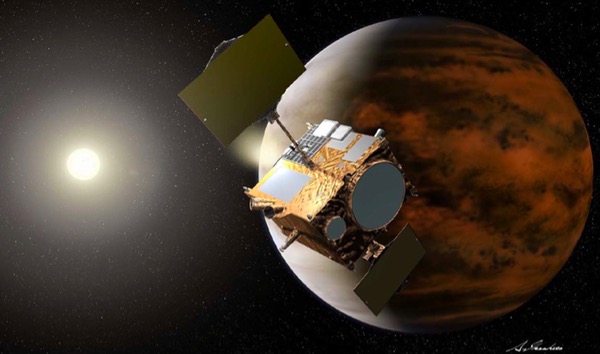Back from the brink: Akatsuki returns to Venusby Ralph Lorenz
|
| The Akatsuki story is particularly interesting for two reasons. First, because the failure was documented in exceptional detail, and second, because the Akatsuki story may yet have a happy ending. |
This compact spacecraft was developed by JAXA to observe Venus from orbit with a set of innovative cameras to monitor its climate, weather, and surface. Unfortunately, Akatsuki's arrival did not go as planned. Orbit insertion is a tense moment for operators of planetary spacecraft. This crucial operation marks the end of a usually quiet cruise, and the busy transition to operations around the target planet and, hopefully, to routine scientific observations. While usually taken somewhat for granted, it poses mechanical and thermal stresses on vehicle components and makes unforgiving demands on attitude and timing. Usually there is only one chance to get it right.
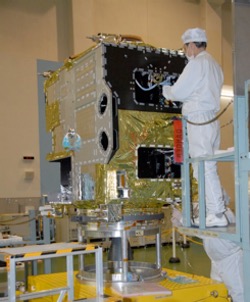 Figure 1. Technicians assembling the rather modest-sized Akatsuki spacecraft. (credit: JAXA) |
Spacecraft have recovered from failed insertion burns before, albeit rarely. The arrival burn of NASA’s Near Earth Asteroid Rendezvous (NEAR-Shoemaker) spacecraft in 1998 was cut short by an unfiltered accelerometer reading, but the spacecraft was retargeted to make a second attempt, a process made somewhat forgiving by the low gravity of the target body Eros. On the other hand, Mars Observer in 1993 was never heard from again after it was due to fire its engine for Mars arrival. Mars Climate Orbiter in 1999 famously arrived at too low an altitude due to a navigation error, burning up in the Mars atmosphere.
The Akatsuki story is particularly interesting for two reasons. First, because the failure was documented in exceptional detail, with telemetry from the propulsion and attitude control system available to reconstruct, like the “black box” on an airliner, the events leading up to the anomaly. JAXA is to be commended on its openness: in the challenges of space we can all learn from others, and some western agencies are not always as forthcoming with technical details of anomalies. And second, because the Akatsuki story may yet have a happy ending.
Let us begin by outlining what was supposed to happen. Akatsuki (“Dawn”) launched from Earth in May 2010, with several secondary payloads including the innovative and highly successful experimental solar sail Ikaros. It reached Venus on December 6, 2010, and should have fired its main engine for 12 minutes to brake into an elliptical equatorial orbit of 300 by 80,000 kilometers. This orbit was chosen because near apoapsis—the highest point in its orbit—the angular motion of the spacecraft matches that of the planet’s cloud tops, enabling exquisite weather observations with its five cameras. Indeed, prior to launch and its naming as Akatsuki, the project was referred to by the more prosaic name “Venus Climate Orbiter.”
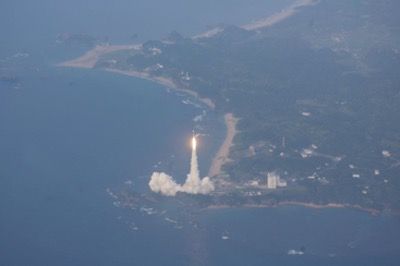 Figure 2. Akatsuki launched on an H-II rocket from the Tanegashima launch complex south of the Japanese main islands in May 2010. (credit: JAXA) |
Like most spacecraft, Akatsuki has an attitude control system using small monopropellant hydrazine thrusters. For major maneuvers, and especially the orbit insertion burn, Akatsuki has a large main engine. For large changes in velocity, the low specific impulse of monopropellant hydrazine would lead to prohibitive fuel loads, and a higher performance system is needed. In many spacecraft this is the hypergolic combination of dinitrogen tetroxide (sometimes abbreviated NTO, or mixed oxides of nitrogen MON) and a hydrazine derivative like monomethyl hydrazine (MMH). The hydrazine derivatives are usually preferred over “straight” hydrazine due to their better chemical stability and lower melting points, which means freezing of the fuel lines is less of a concern. Cassini, for example, with a launch mass of over five tons, has a monopropellant hydrazine attitude control system and a separate bipropellant system for orbit insertion and large maneuvers.
Of course, there is a certain dry mass overhead in having two essentially independent systems, with three different tanks, and this overhead is proportionately more demanding for smaller spacecraft like Akatsuki, whose launch mass was only 517 kilograms. A more elaborate engine design to use straight hydrazine, and greater care to avoid freezing, allows a single hydrazine supply to be used in a main bipropellant engine as well as in small thrusters as a monopropellant, a so-called “dual mode” propulsion system. One such engine is the Leros engine developed by Royal Ordnance in the UK in the 1990s, used in several European telecom satellites as well as MESSENGER and the Mars Reconnaissance Orbiter.
| The only way to develop this much torque is if much of the engine thrust were pushing not along the x-axis as it had been, but were suddenly emerging partly sideways. The conclusion is clear: part of the nozzle fell off! |
The throat and nozzle of a bipropellant engine sees exceptionally high temperatures, and careful design and often expensive exotic materials are needed (for example, the Leros engines use a niobium alloy nozzle with a disilicide coating.) Correct fuel flow is critical, with engines being run slightly fuel-rich. This creates a film of fuel vapor helping limit the heat load on the walls of the combustion chamber and nozzle throat, a process known as “film cooling.”
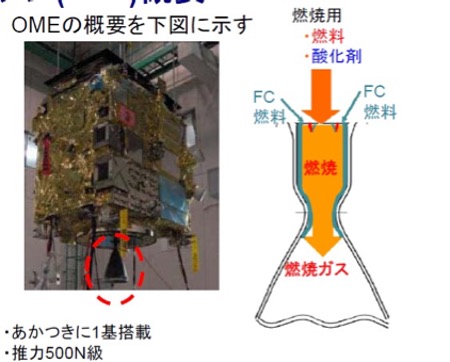 Figure 3. The underside of Akatsuki and the nozzle of the orbiter main engine (OME). The schematic at right shows the injection of fuel and oxidant into the engine, with the blue streams of fuel indicating the film cooling (FC) effect. (credit: JAXA) |
Japanese science missions usually include a number of new technologies, and Akatsuki flies several, such as flat slot array high-gain antennas, a lithium-ion battery, and a 500-newton main engine that has a nozzle made with a novel ceramic, silicon nitride (Si3N4), rather than expensive niobium. JAXA issued a press release during cruise that, on June 28 at a distance of 14.6 million kilometers from the Earth and 1.06 astronomical units (AU) from the Sun, Akatsuki made the world’s first engine burn using a ceramic thruster in space, firing for 13 seconds.
The propulsion system schematic shows how fuel (N2H2) and oxidizer (MON3) are forced into the engine by a helium pressurant (GHe). The pressure upstream of both the fuel and oxidant tanks is maintained at a constant level by one of two pressure regulators (RG-1 and -2), and the gas flows through valves (CV-F, CV-O, and GLV) intended to avoid upstream migration of propellant vapors (it was such migration that may have been responsible for the Mars Observer failure.) The gas pressure in the tanks forces the propellant through the lines into the Orbiter Main Engine (OME).
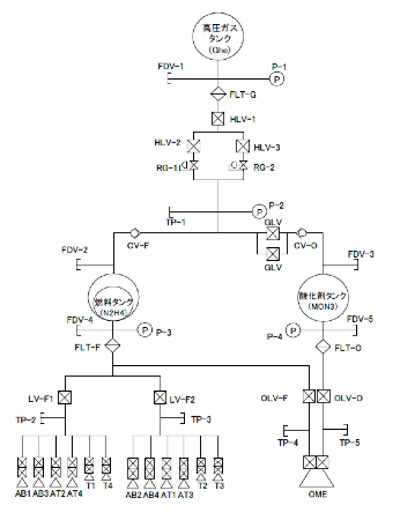 Figure 4. Schematic of Akatsuki’s propulsion system, showing how the helium pressurant (GHe) is conducted to the hydrazine and oxidant (MON3) tanks via pressure regulators and valves. The cause of the pressurization failure during the 2010 insertion burn is the fuel-side check valve CV-F, which did not allow sufficient helium flow, and in turn restricted the fuel supply to the orbiter main engine OME. Note in this dual-mode propulsion system the hydrazine (N2H2) supply feeds various small thrusters AB, AT, and T, as well as the main bipropellant engine. Various other valves, filters (FLT), and test points (TP) are shown. Note also the location of the pressure transducers (P-1 to P-4), which allowed the failure to be diagnosed. (credit: JAXA) |
So much for what was supposed to happen. Inspection of the recorded telemetry reveals what actually happened (the spacecraft was in fact occulted by Venus when this was going on, so there was no real-time communication with Earth when the burn started.) The burn began exactly as planned: the acceleration of the spacecraft is as expected, indicating nominal thrust levels (Figure 5). Over the course of the burn, as the spacecraft becomes lighter as the fuel is burned, the constant thrust should lead to progressively higher acceleration levels. But while the oxidizer pressure is constant, indicating correct operation of the regulator and good helium flow on that side of the system, the fuel pressure appears to be declining (Figure 6). This suggests that the valve upstream of the fuel tank is not allowing helium to flow in, and thus as the fuel is progressively expended, the gas volume (“ullage”) behind the fuel is expanding, and the fixed mass of gas must therefore fall in pressure. In effect, the fuel side is operating in a “blowdown” rather than regulated mode.
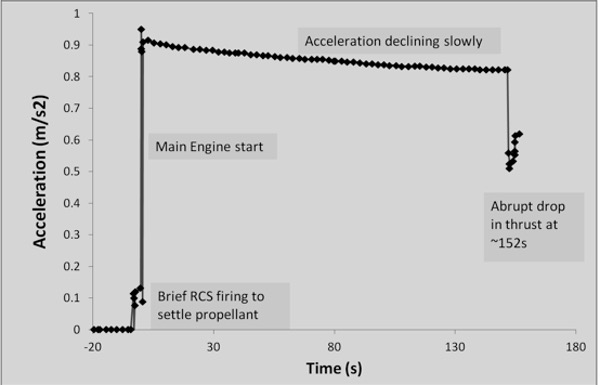 Figure 5. Acceleration history during the 2010 insertion burn. A brief ullage burn by the RCS thrusters settles the propellant at the bottom of the tanks and the main engine fires at t=0s. The acceleration of about 0.9 m/s2 (one tenth of a “g”) indicates the engine is producing over 400 newtons of thrust, given the spacecraft’s approximate mass of 500 kilograms. However, this thrust should be constant and so as the fuel mass declines, the acceleration should rise. Instead, the thrust falls slowly until a sudden drop at 152 seconds. |
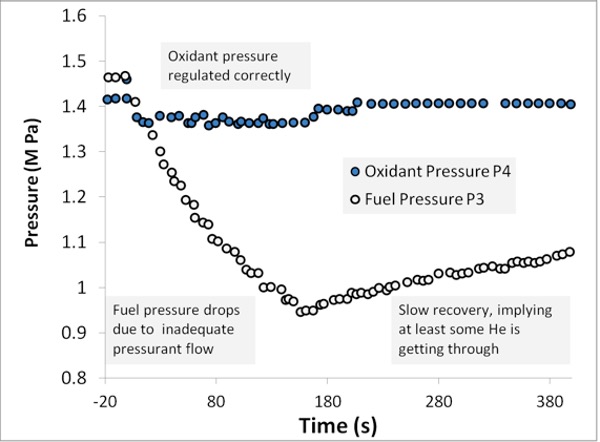 Figure 6. The pressure histories tell the story of what happened. The regulated upstream pressure P2 (not shown) remains constant at 1.4 MPa throughout, as it should. The oxidant pressure P4 also behaves as it should, roughly constant at 1.4 MPa, although with a slight drop while oxidant is flowing into the engine until 152 seconds. However, the fuel pressure drops precipitously during the burn due to inadequate helium flow. When the burn is stopped at 152 seconds, the pressure slowly increases, implying that some helium is getting through, just not enough to keep pace with the expanding ullage volume above the fuel when the engine is firing. |
With the fuel pressure declining, the fuel flow into the engine becomes reduced, and the thrust falls, as evidenced by the spacecraft acceleration history, which is falling from its initial value of 0.9 m/s2 (0.09 g) instead of rising. By itself that might not be critical: engine underperformance can sometimes be made up simply by running the engine for longer. But while the fuel flow was falling, the oxidant flow remained constant as it was supposed to, and so the fuel-oxidant mixture in the engine became progressively leaner, allowing combustion temperatures and especially the nozzle throat temperature to increase.
| An in-flight test, firing the engine for a couple of seconds, found that only about a tenth of the nominal thrust was generated, suggesting that probably the whole nozzle had come off, fractured near the throat. The engine was useless. |
After 152 seconds, this temperature rise led to a sudden change. The thrust drops precipitously (the acceleration dropping to about 0.5 m/s2), but the real key is in the attitude control data. Whereas up to this point, the attitude rates are all low (Figure 7), indicating a steady orientation, at the same instant as the thrust drop, the x-axis angular velocity suddenly starts ramping up. The angular velocity increases at about 5 degrees per second per second (Figure 8): this acceleration requires a strong torque to be whirling the spacecraft around. In fact, the only way to develop this much torque is if much of the engine thrust were pushing not along the x-axis as it had been, but were suddenly emerging partly sideways (Figure 9). The conclusion is clear: part of the nozzle fell off!
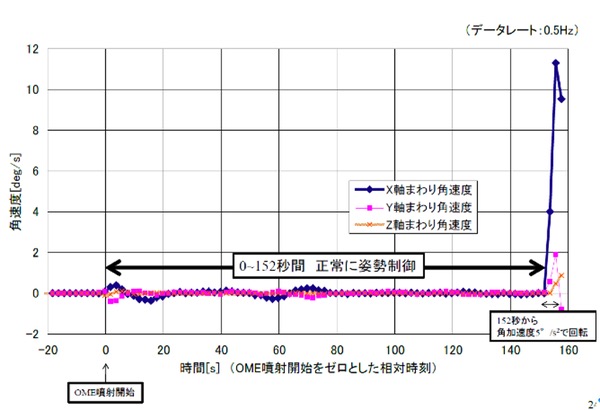 Figure 7. The attitude history during the burn (this plot retained in the original format from the JAXA report.) There is a slight wander in the angular rates that start, as one might expect, at the beginning of the burn, but everywhere the rates are below one degree per second, until a sudden rise at 152 seconds, just when the engine thrust drops. |
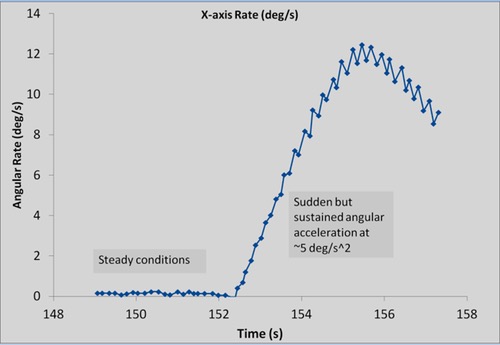 Figure 8. A zoom of the angular rate data at the moment the thrust dropped. From a steady attitude hold with near-zero rates, the x-axis rate suddenly begins climbing at a constant rate to about 12 degrees per second in a couple of seconds, implying a huge torque on the spacecraft. The oscillation in the trace indicates some nutation or precession. The change in evolution at 155.5 seconds may indicate a second change in the configuration of the nozzle, perhaps the rest breaking off. |
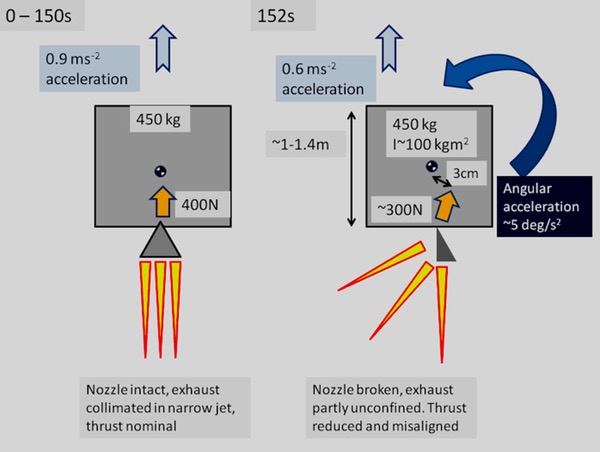 Figure 9. Schematic of the change in thrust conditions at 152 seconds (exaggerated for clarity). Akatsuki’s dimensions are 1.4 x 1.4 x 1 meters: assuming a moment of inertia for a uniform ~1.2m 450 kilogram cube of about 100 kgm2, then an angular acceleration of approximately 5 degrees/second2 (~0.1 radian/second2) requires that a torque of about 0.1 * 100kgm2 = 10 Nm was applied. If the thrust was about 300 newtons, then a misalignment of the thrust vector by about 3 centimeters, or 4 degrees, would have the observed effect. |
Had this been a conventional metal nozzle, it would likely have partly burned through, perhaps seeing some sideways thrust, and would have some thrust drop. Eventually the result might have been the same, but the degradation would probably have been more gradual, whereas the ceramic material cracked suddenly with the thermal stress, giving a very sharp change in the thrust and torque.
As the angular rate climbed to 12 degrees per second, the spacecraft’s on-board fault protection recognized that something was badly wrong, and shut down the engine. Akatsuki sailed past Venus without stopping.
JAXA controllers quickly diagnosed the status of the vehicle, and managed to snap a few pictures of the planet before the spacecraft receded to a distance where Venus shrank to a point, at least demonstrating that several of the cameras worked. The telemetry recording the propulsion system behavior pointed to the culprit. After the engine burn, the fuel-side pressure slowly climbed back to the intended level, implying that some helium was getting through to the tank, just not quickly enough to keep up with fuel usage during the main engine burn. It seems the non-return valve had been (mostly) held shut, perhaps by salts formed by corrosion of the valve seat by fuel vapor. That couldn’t be fixed, now, but perhaps the main engine could be used in short bursts.
Tests on the ground replicated the failure of the engine under low fuel flow conditions, and indeed the nozzle fractured. How much nozzle was left in flight? If part of it was present to cause asymmetric thrust, perhaps the spacecraft could be spun for stability during engine burns? And if engine burns were kept short (as had been the first burn, before orbit insertion), the helium pressure drop could be limited to safe levels. But an in-flight test, firing the engine for a couple of seconds, found that only about a tenth of the nominal thrust was generated, suggesting that probably the whole nozzle had come off, fractured near the throat (figure 10). The engine was useless.
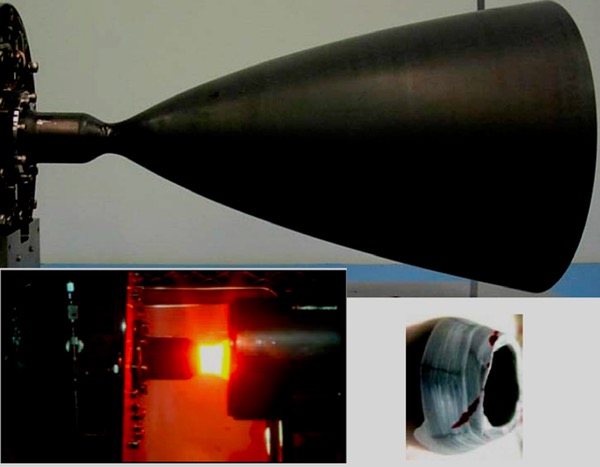 Figure 10. Montage of several JAXA images showing the ceramic engine and nozzle above, and the intense heating (lower left) the throat sees during operation, especially when fuel-starved. Excess temperatures caused the ceramic to crack, most typically at the throat region (lower right). |
And so was the oxidant. Without a functioning bipropellant engine, this normally precious resource was just dead weight. Controllers took the rather drastic step of dumping the NTO, hosing it out cold through the engine without any fuel (even without combustion, the oxidant was still reaction mass, so this operation was conducted in a useful orientation). The hydrazine could still be used through the small monopropellant thrusters, and with the spacecraft lightened by the jettison of the oxidizer, there would be just enough delta-V to limp into orbit when Akatsuki re-encountered Venus.
| It remains to be seen whether the second insertion attempt will be successful, and what science Akatsuki will be able to perform for how long, but any observations at all will be a bonus. No other missions to Venus are presently under development. |
But that would be five long, hot years later. Akatsuki was in a resonant orbit with Venus, which would make nine revolutions around the Sun (each orbit 203 days long) while Venus made eight (225 days) and the Earth made five. This orbit took Akatsuki to within 0.6 AU of the sun, rather closer than the 0.7 AU for which it had been designed, and its systems would be cooked: a tenth of an AU doesn't sound like much, but it’s the difference between 2.65 kW/m2 of sunshine and 3.6 kW/m2 (Figure 11). A long sojourn in interplanetary space also gives time for other things to go wrong: Akatsuki had only been designed for a mission of two years, plus its six-month cruise to Venus. And JAXA had sad experience of a similar challenges: in 1998 its Nozomi spacecraft also suffered a propulsion failure, causing it to take an extra four years to reach Mars, but on route it was hit by an intense solar flare and shortly thereafter some of its electronics failed, and it sailed helplessly past Mars in 2003. So far, at least, no such problems have been reported with Akatsuki, but whether the repeated high-temperature cycles have degraded Akatsuki's battery or any of the payloads remains to be seen.
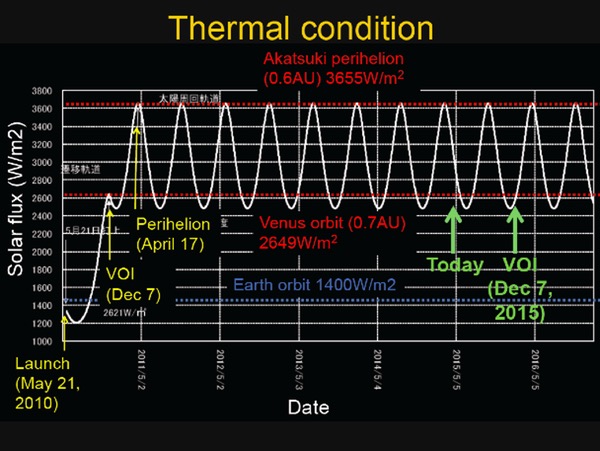 Figure 11. The formidable and unanticipated heat load on Akatsuki throughout its mission, from a JAXA presentation in February 2015. The spacecraft is enduring its final perihelion passage as this article is being written in August 2015. (credit: JAXA) |
Now, nearly five years later, JAXA says that it has made the final trajectory adjustments to allow Akatsuki to try again. In July 2015, Akatsuki’s hydrazine thrusters nudged its path to line up for an orbit insertion on December 7. The reduced performance of the monopropellant system will not allow the original orbit to be attained: the spacecraft can only just be captured into a long orbit (perhaps 5000 x 300,000 kilometers) that will take it much farther from Venus than the original mission plan. However, there will be opportunities to use the instruments at the original ranges, as well as further away (figure 12). Software has been developed to crop out the interesting segments of images (i.e. “subframing”) taken at longer ranges where Venus will fill only part of the field of view, allowing more efficient use of the data link. And Akatsuki's novel instruments still have exciting potential for new discoveries.
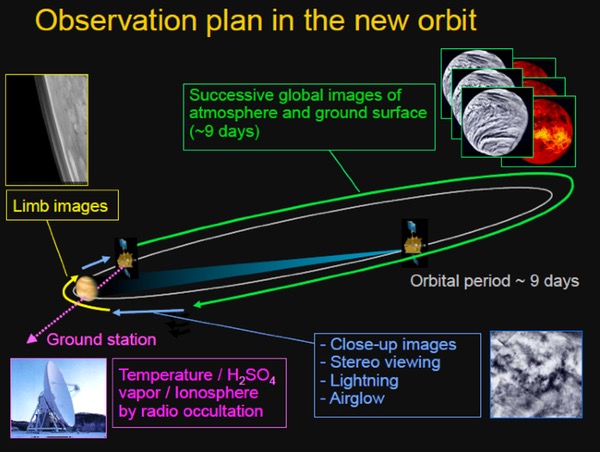 Figure 12. Observation plans in the new, high-altitude orbit. (credit: JAXA) |
The thermal and ultraviolet cameras will image the cloud structure, measuring the dynamics of the atmosphere. Two near-infrared cameras will show the evolving cloud structure at different levels in the atmosphere, and these instruments together will expand on findings from Venus Express. The near-infrared cameras also probe “window” wavelengths where some emitted light from the surface filters up through the clouds and the planet’s thick greenhouse gas. Venus Express was able to only map part of the surface this way and so Akatsuki may complete this coverage, perhaps finding areas of unaltered material indicative of recent volcanic eruptions. One remote possibility is that present-day volcanic activity might be detectable by the near-infrared glow of hot lava, which in principle could be detected by these cameras (and indeed a couple of claims, not widely accepted, of such transient emission have been reported in analyses of near-infrared data from Venus Express.) However, close examination of the numbers shows that robust detections would require exceptional volcanic eruptions, seen on Earth only every few centuries. Nonetheless, if any such emission should be visible, Akatsuki is well-equipped to detect it.
Finally, a novel high-speed lightning and airglow camera, with a modest 64 pixels but blazing away at 50,000 frames per second, may settle the question of whether the clouds of Venus have lightning discharges. Radio occultation experiments may also be performed, profiling the temperature structure of the atmosphere near the cloud tops.
It remains to be seen whether the second insertion attempt will be successful, and what science Akatsuki will be able to perform for how long, but any observations at all will be a bonus. No other missions to Venus are presently under development: while Venus scientists hope that this mission drought may end through NASA’s Discovery and New Frontiers programs, nothing will reach Venus until the mid-2020s.
 Figure 13. JAXA public relations developed two mascot characters, Akatsuki-kun and Kinsei-chan, referring to Akatsuki and Venus respectively, with the honorifics for “little boy” and “little child”. These mascots appear in a motif developed half a decade ago, after the orbit insertion failure, expressing the hopes of the insertion re-attempt that will shortly be realized. |
The Fates have not been kind to JAXA, with Akatsuki’s challenges following the anguished attempts to get Nozomi to Mars. However, despite crippling difficulties at asteroid Itokawa, JAXA managed to nurse its Hayabusa spacecraft back to Earth with a few precious grains of asteroid samples in its return capsule. JAXA has shown a heroic resilience when confronted with these challenges, and its cautiously defiant optimism on Akatsuki was captured in a cartoon image generated after the failure. Kinsei-chan awaits!
